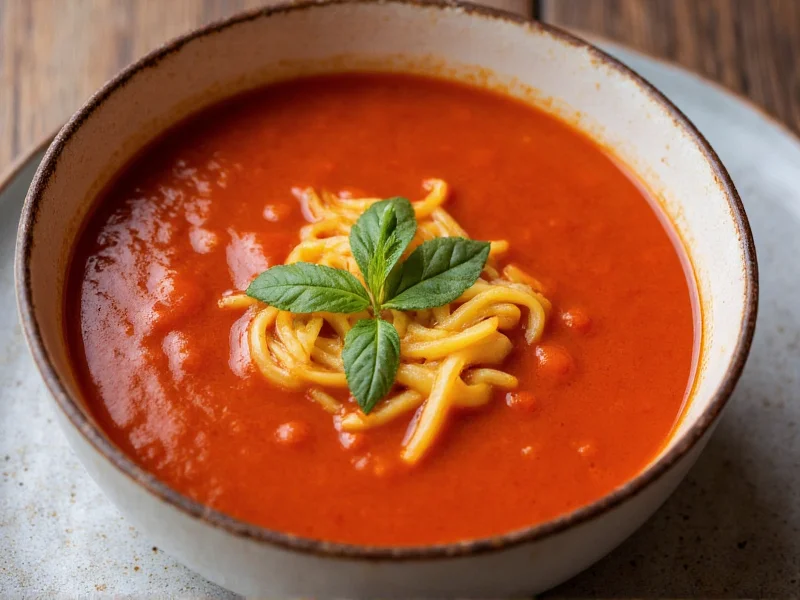Making delicious soup from tomato paste is one of the most practical kitchen skills for busy home cooks. Tomato paste offers concentrated flavor that forms an excellent base for quick, satisfying soups when fresh tomatoes aren't available. Unlike tomato sauce or puree, paste has been reduced to intensify its natural sweetness while removing excess water, giving your soup a richer foundation without lengthy simmering.
Why Tomato Paste Makes Superior Soup Base
Tomato paste undergoes a double-concentration process that removes approximately 80% of the water content found in regular tomato products. This concentration dramatically increases the lycopene content and natural sugars while developing complex umami flavors through caramelization during manufacturing. When used as a soup base, tomato paste requires less reduction time than fresh tomatoes or canned crushed tomatoes, making it ideal for quick weeknight meals.
Essential Ingredients and Substitutions
The beauty of tomato paste soup lies in its flexibility. While the basic formula remains consistent, you can adapt ingredients based on dietary needs and pantry availability. The following table shows reliable substitutions that maintain soup quality:
| Original Ingredient | Recommended Substitution | Notes |
|---|---|---|
| Tomato paste (6oz can) | 3-4 tbsp tomato paste + 1 cup broth | Maintains proper concentration ratio |
| Chicken broth | Vegetable broth or water + 1 tsp yeast extract | For vegetarian/vegan version |
| Heavy cream | Cashew cream or coconut milk | Provides similar richness without dairy |
| Fresh basil | 1 tsp dried oregano + 1/2 tsp dried basil | Use half amount when substituting dried herbs |
Step-by-Step Preparation Guide
Follow these professional kitchen techniques to transform tomato paste into exceptional soup:
- Bloom the paste: Heat 1 tablespoon olive oil in a medium pot over medium heat. Add 1 minced garlic clove and sauté for 30 seconds until fragrant but not browned.
- Concentrate flavors: Add 1 can (6 oz) tomato paste and cook, stirring constantly, for 3-4 minutes until the paste darkens slightly and separates from the oil. This crucial step develops deeper flavor.
- Gradual liquid addition: Slowly whisk in 2-3 cups broth, starting with small amounts to prevent clumping. Continue whisking until smooth.
- Simmer properly: Bring to a gentle simmer (not boil) and cook for 15-20 minutes to allow flavors to meld. Boiling can make the soup bitter.
- Final enrichment: Remove from heat and stir in 1/4 cup cream or milk if desired. Season with salt, pepper, and 1 tsp sugar to balance acidity.
- Texture refinement: For smooth soup, use an immersion blender directly in the pot. For chunkier texture, leave as-is or add diced vegetables during simmering.
Avoiding Common Tomato Paste Soup Mistakes
Many home cooks encounter issues with tomato paste soup that stem from improper technique rather than ingredient quality. Understanding these pitfalls ensures restaurant-quality results every time:
- Bitterness development: Tomato paste burns easily due to its concentrated sugars. Always cook it with fat (oil or butter) and stir constantly during the blooming stage. If your soup tastes bitter, add 1/2 tsp sugar and a splash of cream to counteract the bitterness.
- Watery consistency: Using too much liquid relative to paste creates thin soup. Maintain a 1:3 ratio of paste to broth (1 part paste to 3 parts liquid) for proper thickness. If soup becomes too thin, simmer uncovered for 5-10 minutes to reduce.
- Flat flavor profile: Tomato paste needs flavor layering. Always include aromatics (onion, garlic), acid (a splash of red wine vinegar), and umami boosters (a Parmesan rind or teaspoon of soy sauce).
- Over-reduction: Simmering too long after adding cream can cause separation. Add dairy at the end and heat gently without boiling.
Flavor Variations to Elevate Your Soup
Once you've mastered the basic technique, experiment with these professional variations that transform simple tomato paste soup into distinctive dishes:
- Rustic Italian: Add 1 diced carrot and 1 diced celery stalk with the garlic. Finish with fresh basil and a drizzle of high-quality olive oil.
- Roasted Red Pepper: Blend in 1/2 cup roasted red peppers and a pinch of smoked paprika for depth.
- Spicy Arrabbiata: Include 1/2 tsp red pepper flakes with the garlic and finish with fresh parsley.
- Creamy Tomato Basil: Stir in 1/4 cup heavy cream and 2 tbsp fresh chopped basil just before serving.
- Tomato Minestrone: Add 1/2 cup small pasta, 1/4 cup white beans, and chopped vegetables during the last 10 minutes of simmering.
Storage and Reheating Best Practices
Tomato paste soup stores exceptionally well, making it perfect for meal prep. Cool the soup completely before transferring to airtight containers. Properly stored:
- Refrigerator: Keeps for 4-5 days
- Freezer: Maintains quality for 3 months in portion-sized containers
- Reheating: Warm gently over medium-low heat, stirring frequently. Add a splash of broth if the soup has thickened too much during storage.
For best results when reheating frozen soup, thaw overnight in the refrigerator before gently warming. Never boil tomato-based soups during reheating, as this can cause separation and develop off-flavors.
Nutritional Benefits of Tomato Paste Soup
Tomato paste contains nearly 10 times the lycopene of fresh tomatoes due to the concentration process. Lycopene, a powerful antioxidant, becomes more bioavailable when cooked with a small amount of fat (like the olive oil used in preparation). A standard serving (1.5 cups) of homemade tomato paste soup typically provides:
- Approximately 150-200 calories (without cream)
- 30% of daily vitamin C requirements
- 25% of daily vitamin A needs
- Significant potassium and fiber content
- Enhanced absorption of fat-soluble nutrients when prepared with healthy fats
For a lower-sodium version, use low-sodium broth and enhance flavor with additional herbs rather than salt. The natural sweetness of properly caramelized tomato paste often eliminates the need for added sugar.











 浙公网安备
33010002000092号
浙公网安备
33010002000092号 浙B2-20120091-4
浙B2-20120091-4